Adapting Capt. Manwaring's comment - You stupid bird
Adapting Captain Manwaring's comment - You stupid bird.
Earlier in the month I mentioned installing two ground bird feeders made from
redundant fridge drawers, see photo accompanying that contribution. These for
sure have become considerable time wasters, both in respect of having to frequently replenish these fast food outlets and from watching the antics of the many avian visitors
to the mesh baskets. Principally it is the Blackbirds that cause most amusement, well
obviously not for them, maybe we should additionally supply a course of medication to
assist them in overcoming nervous exhaustion.
They just run around almost frantic trying to find a way in and some getting quite angry
with others, spending time attempting to aggressively shoo off competitors, whilst more sensible types are plundering the other feeder. From these observations I am ever more convinced that birds, and I mean all of them, including some that pet owners think
are intelligent, are really pretty stupid and largely their minds are governed almost exclusively by instinct and not sensible thought. Fact, they are zoologically not too far removed from reptiles, and of course they still have scaly legs, the ring of bones - sclerotic plates - around their eyes and other anatomical features found in lower types of vertebrate.
Further, they lay eggs!
There is a well argued theory, with which I agree, that the Dinosaurs never really became extinct and the class Aves with which we are so familiar, are modern day members of this clade. But of course most of them are much prettier than dinosaurs, lizards, turtles crocodiles etc, and, quite a few taste good!
Having acquired reasonable experience dissecting the carcasses of birds, done in the need to secure avian skeletons to assist with identifying prehistoric discoveries, principally from Walton's Naze, I have handled many modern bird skulls. This certainly impresses one with the great osteological diversity found in members of this Class. Also, it becomes obvious that the crania largely have evolved to pay no great attention to the need for intelligent thought. I marvel at say the skull of the Curlew, or the owl and those of the diving birds, all equipped for their special feeding habits.
Whatever, these most familiar creatures provide the greatest pleasure for a host of human admirers, whether our feathered friends are brainy or otherwise.
And I should make it clear my skeletal collection of modern types is composed entirely
of birds that have died from natural causes, exception being the turkey and chicken
specimens. One of the latter incidentally is of a Dorking Fowl that has, along with the
Silkies, five toes.
Finally to briefly digress.
We visited my wife's niece in Hadleigh and admired a very attractive bush in her garden.
This planted by her property's previous owner, so its name remained unknown.
Assisted through the knowledge of another relative who examined my photograph, was
told that it was a 'Yesterday, today and tomorrow ' plant - see various images on the
Internet. Our Hadleigh relative duly accessed this information source and was unconvinced that this was true for her shrub and indeed further enquiries led to its correct identity. Recalling several recent contributions to the Forum, now interesting to report the bush is a variant, man imposed, of Sambucus, yes the Elder and it bears the common name Black Lace. Not quite the best description because it has beautiful alternate light and darker mauve flower heads - very pretty as is the dark foliage. 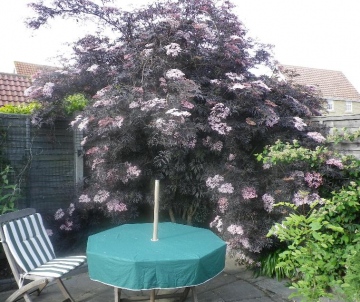
Member's thoughts on all the above will be appreciated. Hoverfly ident
The main obvious thing excluding Syrphus is the shape of the yellow bars across the abdomen. The shape of the markings of Eupodes corollae are very variable and may or may not be joined, but do not resemble the band shape of Syrphus. Syrphus have the squama (lower lobe at the base of the wing) with long hairs on the dorsal surface but you will almost certainly not be able to see this in a photograph. However to identify Syrphus correctly to species requires microscopical examination of characters, as does the id of many hoverflies. Alan Stubb's British Hoverflies published by the British Entomological and Natural History Society is a must for anyone wanting to do hoverfly identification. Hoverfly ident
Peter searching the web I think you are right, but it is very difficult to tell. There seems to be one or two image sites that are showing both species under the same name. However corolle appears to have the main abdominal spots joined by a parrallel belt. Is this an I.D. point?
Not Syrphus ribesii, but probably Eupeodes corollae Syrphus ribesii (female) ?
Recently a pupa was found on a Cypress growing as an ornamental pot plant in Chanterelle, Colchester. The below photograph was taken and the pupa, which at this time was unidentified, placed in a box to await emergence of its occupant. Yesterday 26.6.2012 the insect emerged, on one of the mildest, balmy, mornings we had in ages. Did it know the conditions were right for it as it had lain dormant for some time after it was found? The emerged insect which I believe is a female Syrphus ribesii, was taken from the box and obligingly sat on my hand preening itself and sunning before taking flight in the garden 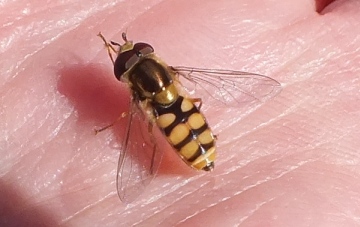 The empty pupa case is pictured below 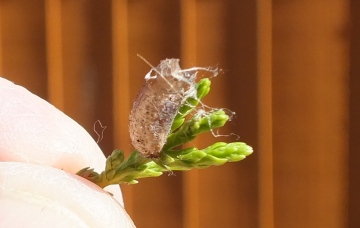 Blackbird on a hot tin roof
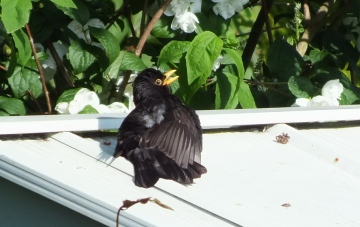 A fine sunny morning, being taken advantage of by this Blackbird. It was watched for some time turning over to sun the otherside, then getting up to scratch and preen, to return to its sunning. Well I suppose we haven't seen a great deal of sun and he was intent on making up for lost time.
Dear Graham
Yes, this certainly appears to be Phymatodes testaceus. I don't know its status in Essex, other than that it is recorded from both VCs including recent years, the books say it is fairly widespread in ancient woodland and pasture woodlands throughout Britain to southern Scotland, and the NBN Gateway and the 1999 BRC atlas show scattered records through the county (but mostly old). I would be grateful for full record details (date, grid reference etc). Beetle Sp and Mary's Garden
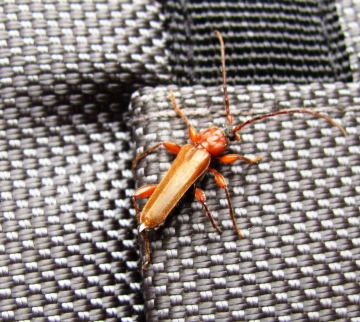
Has anyone any ideas on this beetle. It appears to be the so-called Tanbark Beetle Phymatodes testaceus but I am quite prepared to be shot down on this. How else do you learn! It is one of the Longhorn Beetles and is apparently of local distribution in southern England, so I'm not sure of its status in Essex. The swollen femora seem to be distinctive. It was found by Barry Hough, the warden of the Backwarden EWT reserve in his garden log pile at Ingatestone, although most of the logs originated from Danbury.
Mary : I've had a wonderful crop of slugs in my garden this spring! There does not seem to be any viable alternative to the blue pellets for controlling them - which I refuse to use - but I have heard that Marshall's have produced a biological control using nematode worms! My only control method is beer traps and I even feel a bit guilty using these as they seem to attract slugs from miles around, most of which had no intention of attacking my runner beans anyway! Like you, I have had a good crop of early potatoes - although I always plant them too close together due to lack of space - but some of the leaf vegetables such as Spinach and Chard are inclined to bolt in this wet weather while the Mange Tout is producing a hell of a lot of leaves but very few flowers as yet. Thank you, Peter
I am delighted to be told to leave my insect hotel alone! Anything for an easy life is what I prefer, where appropriate. But I am sorry to say I am not really able to collect specimens, especially as most are in the air when I see them.
But please feel free to drop in to collect what you can, but let me know first when you want to arrive. Re: Buttercups and odds and ends
In answer to Mary's post of 19th and question about the insect hotel and should she clean out the used holes in the winter, to remove the varied detritus within? Or leave well alone, as some tenants may be overwintering in there? DEFINITELY leave well alone.
All or nearly all the occupants using the holes will be nesting solitary bees and wasps, which make partitioned cells that they provision with pollen (from whichever plants that particular bee species collects) or with paralysed prey (whichever prey are used by that particular solitary wasp), on which they lay an egg in each cell. The egg hatches, the larva feeds on the food supply, then pupates, and will over-winter until the adult season period the following year. In addition there will probably be some nests 'parasitised' by cuckoo bees and wasps (cleptoparasites) adding to the interest and diversity. Cleaning the hotel out would destroy all these efforts and the next generation of insects.
So life is simpler than for the whole garden or gardener - just leave well alone and watch what inhabits the holes every year (identification of the species of bee and wasp which are using the hotel would require good quality close up photographs for some species and an actual specimen for most. in my garden
Raspberries are at last starting to ripen. Usually they begin just before mid June, so are a week late. I have picked a meal's worth of Horse Mushrooms from my lawn. These are about 3 months early. And I have a huge crop of potatoes, much earlier than usual. What on earth is going on? I know we have had some very strange weather this year, but some things early and and others late makes no sense to me at all. Comments, please? Thanks for ident Peter
Thanks Peter for the ident on Merodon equestris. It would seem to be the insect I photographed, which was first spotted in an area of the garden where we have a patch of bluebells. This ties in, as researching the web it was found that they go for the hyacinth family in particular. It very interesting to see that Graham has more or less the same insects in his garden as ours in North Colchester including the bee Bombus hypnorum, which I first spotted near Tescos Highwoods last year. Buttercups and odds and ends
At pesent I am visiting the area around Aveley and South Ockendon quite a bit, botanising. This is just past mid June, and I am only finding two species of Buttercup, one of which is not allowed now. The Bulbous B. is supposed to flower in April, which it did, but not as early or as readily as usual, mainly due to the exceedingly cold and wet month we had. They are, however, still in flower, which they are definitely not meant to be in mid June. There should be Meadow B. out now, and, indeed, should have been for some time, but I have not seen a single one out yet. Creeping B., often the most conspicuous of the three in heavier soils, is flowering, but not as showy as usual. But what has happened to Meadow B.?
Having just read Graham's piece written today, I don't know how he knows all the plants, all the fungi, and, it would seem, nearly all the insects as well! I take my hat off to you, Graham! But you need to be told a secret about gardeners. A friend of mine married a gardener, and a delightful fellow he is, but my friend has now learnt there are two rules of gardening. First, a garden is never perfect, therefore, you are not allowed to just sit and watch for pleasure, as there is always work to be done. Second, a gardener will choose plants with foliage of any colour you fancy, except green. These two together rule out me completely, and, I suspect, Graham too. He clearly thinks he can just enjoy a garden, and I do that too, though with much less knowledge about the beasties than Graham.
This year our insect hotel has had lots of tenants, some of whom are still present. Last year was the first year the hotel was available for renting rooms, but we only had two or three takers. However, a friend told me not to worry, but seasoned holes in wood are preferred, so more visitors arrive every year as the holes get more insect-friendly. But I am sorry to say that I have no idea of the names of any of my tenants, which is a huge oversight. I cannot even say which family different ones belong to. But I do know there are many different shapes and sizes, so some of them at least must be pleased that a hotel is provided for them. One question: should I clean out the used holes in the winter, to remove the varied detritus within? Or leave well alone, as some tenants may be overwintering in there? June 3rd - 9th 2012
A rum week. The weather was foul and wet for the Queen's Diamond Jubilee River Pageant on 3rd - an event ruined for me by the BBC's dismal coverage of the proceedings - but was slightly better for the following two day's celebrations. Rain returned in force on 7th while the next day storm force winds threatened to deposit my greenhouse in a neighbour's garden. Flaming June!
Spent the morning in the garden on 4th - sitting, reading, drinking tea, contemplating my navel, and enjoying the wildlife to be found there - the garden, that is, not my navel! Afterwards, of course, there followed guilty feelings about not "doing something useful". Sad. It's about time I taught the Victorian work ethic to know its place!
My most pleasing discovery was that the Tree Bumblebee Bombus hypnorum has at last reached my garden. It's about time - it seems to have reached everyone else's. Easily identified by the combination of orange thorax and white tipped abdomen, it is one of the few bumblebee success stories of recent years, having spread from Europe and colonised much of southern England. Other bumblebees were scarce - as they have been throughout this spring - the commonest being the orange tailed Bombus pratorum, workers of which were carrying sacs of pollen back to their nest in my old compost heap. Equally pleasing was to see two pairs of Large Red Damselfly mating and egg laying in my pond. I say 'pond' but natural succession is gradually turning it into a swamp, especially since I introduced the rapidly spreading Fine-leaved Water Dropwort into it, and I have to frequently do battle with it in order to free up a few areas of open water where the Smooth Newts and Rams-horn Snails can breed. The leaves of the persicaria overhanging the pond were adorned this morning with several Helophilus pendulus, a yellow, stripey-thoraxed hoverfly whose larva feed in the salubrious surroundings of wet compost and farmyard drains. Six other common species were also present, including the Lesser Bulb Fly Merodon equestris, which Peter saw in his garden, and whose grubs wreak havoc with my Bluebell bulbs. A similar looking species is, as he mentions, Volucella bombylans, but the larvae of this species are scavengers in bee nests and the one seen today may have had its eye on the Bombus pratorum nest in the compost. It's distinctive cousin, Volucella pelluscens, which has a broad white band across the abdomen - and whose larvae live in the nests of social wasps - was also present, as too the familiar Drone Fly Eristalis tenax. The grubs of this species are know as Rat-tailed Maggots as they possess an extendable tube of up to eleven inches in length which enables them to breath fresh air whilst deep within the unspeakable gunge which they often inhabit.
Two common insects not found in the garden before - probably because that previously mentioned work ethic is always getting in the way - were the Cream-spot Ladybird and this early instar of the Speckled
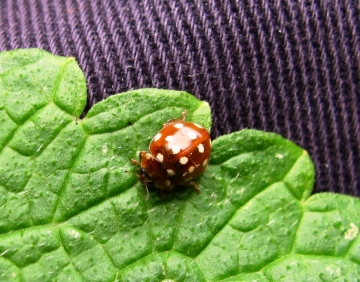
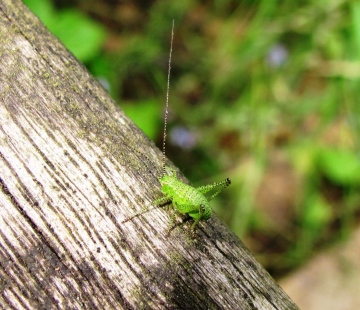
Bush Cricket, so it was good to welcome them to a plot that certainly looks a bit wild at this time of year
and - on this morning's evidence at least - has plenty of life in it as well.
The rest of the week was more suited to fungi than insects and I found this fine clump of Chicken of the Woods Laetiporus sulphureus on a four hundred year old Yew at Fryerning Churchyard, a tree it will
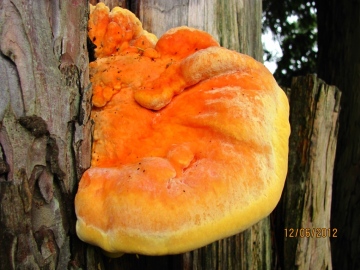
probably help kill in the end. The Germans are alleged to consider this species a delicacy but I am not sure how they prepare it. Grated on salad perhaps? It certainly looks quite tasty in its fresh state. One plant I did find, while helping the Head Ranger, Chris Huggins, with a wild flower walk at Mill Fields,
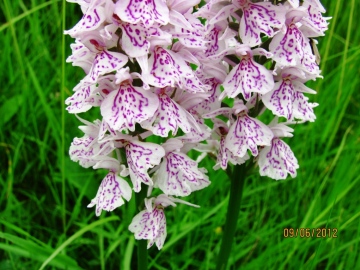
Billericay, was this orchid, one of several hundred on view that day. I have it on the highest authority - the Botanist in Chief no less - that these are Heath Spotted Dactylorhiza maculata, rather than the more familiar Common Spotted Orchids D. fuchsii. The principal distinguishing feature of the former is that the central lobe of the lower lip is as long or shorter than the two laterals and less than half as wide as them, the central lobe being longer and wider in the Common Spotted. This can, I hope be seen on the photo! The Heath Spotted is far commoner in the wetter north and west of Britain, so the person who first looked at these critically and re-identified them deserves a pat on the back.
Looks like Merodon equestris, a hoverfly which develops inside bulbs and which occurs in a range of different colour forms. Help please
This fly was spotted in the garden on 17 June. At first I thought it was Voluculla bombylans but was not sure about the gingery hairs around the thorax. I realise that this hoverfly can vary according to the species who,s nest is scavenged. However it does give the appearance of Leucozona lucorum, but was on the large size for this insect. It was a slow flyer staying in the lower plants in a sunny border but very restless landing on sunny foliage very breifly before moving on. It appeared to follow white tailed bumble bees around the campunula flowers. Fungus
Michael, your fungus would appear to be a member of the Peziza, otherwise known as the cup fungi. Beyond that I cannot go as there are a number of species that grow on rotting wood or plasterboard; I even found a nice collection once on a rotting doormat!
Peter, I see what you mean! I think we all need cheering up this weather. So her's something else - a photo of Fryerning Churchyard taken a few days ago. It has been so wet spring that they have not been able to
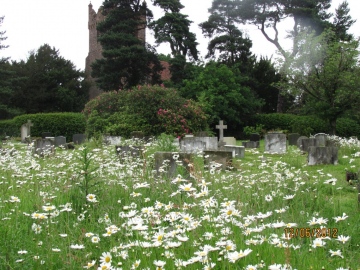
cut the grass but I'm sure the deceased - my parents and grandparents among them - will be happy enough to reside among this sea of Dog Daises and other wild flowers. It is with the living where the problem lies, as many see such a scene as synonymous with neglect and disrespect for the dead. The fungus - more info
Should have added indication of size, would say around an inch and
here's another view. 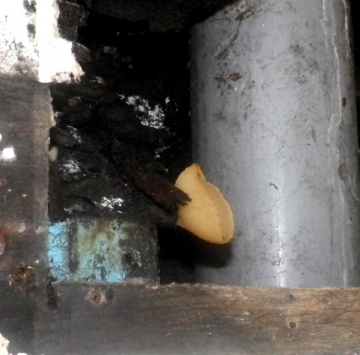 A leaky roof exposes fungus
This rain of late managed to find its way in through our roof. So I had
some remedial work to do. In so doing found this growth when I removed
some saturated plaster board. I do not profess to have any knowlege of
fungi, but thought someone will make some comment and put a name to
it. 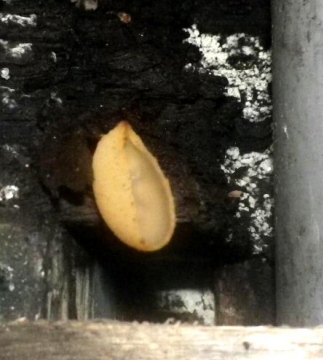
When I took the following photograph of a what I believe is a Dog Rose (Rosa canina) I didn,t realise I had cause it so much pleasure. It wasn,t until it was put on my laptop that it's little cheerful face was noted. 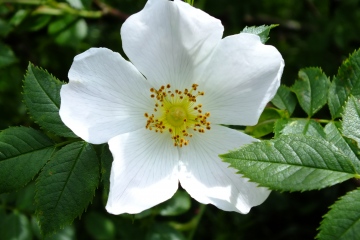 If you click on the photo to enlarge it you will see what I mean. Transit of Venus
Michael - I did set the alarm early but one look out of the window was enough to tell me that the only thing on view was rain clouds - so I went back to bed. The breakfast news showed several hardy souls braving the weather somewhere up north, in the forlorn hope that the clouds would clear, but they had no luck either. Hope they had a good breakfast to compensate!
On a completely different note, does anybody know what this insect is. It was photographed in Hawes Wood, on the edge of Stow Maries Aerodrome last week, but I haven't a clue as to what it is.
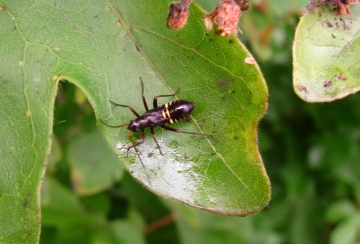
Have been watching the present series of Springwatch on BBC TV. These appear to have shown an
improvement on previous programs - with less contrived hilarity which was found unnecessary distracting.
Their box containing a Blue Tit family fell fowl of the atrocious weather over the extended Jubilee weekend.
Our brood, perhaps luckily, fledged and departed the nest on the Saturday. I say luckily, but what was their
fate out in the wider world to be drenched by those Sunday monsoons and other downpours since? As
was pointed out on the program, the fierce rain would have washed the bird's largely catapillar food out
of the foliage on to the ground thus not the place where Tit parents would have foraged for vital supplies.
So our little family also may have been in trouble, but I do notice that ground beneath some of the thickest
cover around this garden still looks fairly dry, therefore, there is still some hope left for their survival.
For our populous ground feeding birds I found an answer to the problem imposed by the ever resident
Wood Pigeons gobbling up all the scraps we put out. Gulls also raid the food and within a few short
minutes all is gone. I must admit to being a bit of a hoarder and when we changed our refrigerator, I
retained the wire drawers er, 'might come in useful' Now they have and by blocking the one open end
with a polystyrene panels suitably drilled to allow access for species up to Blackbird size, these
selective feeders have proved most successful. 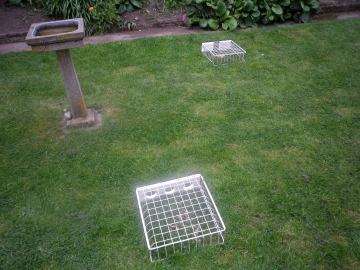 Initially we had some very frustrated looking Woodies
and it was quite amusing to watch one female Blackbird perched on the wire becoming near demented
with the sight below of a delectable meal just out of reach. But she and her fellows eventually reasoned
those end holes provided were the way in to secure sustenance both for themselves and for several
broods. Dunnocks, Sparrows and Robins also being reared in the close by large privit hedge, and the
species last named possibly in an open box I provided, but they all entered through the mesh - no
problem and do they eat! Initially we had some very frustrated looking Woodies
and it was quite amusing to watch one female Blackbird perched on the wire becoming near demented
with the sight below of a delectable meal just out of reach. But she and her fellows eventually reasoned
those end holes provided were the way in to secure sustenance both for themselves and for several
broods. Dunnocks, Sparrows and Robins also being reared in the close by large privit hedge, and the
species last named possibly in an open box I provided, but they all entered through the mesh - no
problem and do they eat!
Graham, as he informs us is still an early riser following his days with the GPO. So Graham did you
manage to see anything of the Transit of Venus? I pondered whether to remind members of this event,
but telling folk they had to be out watching at four am and with only the faintest hope of seeing the
Transit, I didn't feel it was worth raising any expectations. My cousin in Australia I imagine fared better,
although they have had quite a few periods of inclement weather.
By the way, my wife does have concern for my being mean to those Woodies, so I throw them some
grain and for her and my reward they kindly leave us donations of guano, especially in the bird bath! May 27th to June 2nd 2012
Buzzards : A few weeks ago DEFRA announced that they were introducing a policy of capturing Buzzards and destroying their nests in order to help Pheasant shoots. They did not bother to inform conservation groups such as the RSPB and Wildlife Trusts of this little ploy while Natural England, which in the past would have had something to say on the matter, has been so successfully neutered that it's role is now purely to implement Government policies on the environment rather than to question them! Fortunately, the RSPB and other independent conservation organisations are under no such constraint and the former led the furore that has just resulted in a shame faced climb down by the minister concerned, Richard Benyon, the proud owner of a 20,000 acre walled estate (and pheasant shoot). The campaign against birds of prey has been mounting in the shooting press since the present Government took over and so too the illegal persecution of raptors countrywide. Earlier this year the RSPB announced that only one pair of Hen Harriers are attempting to nest in England this summer even though it is considered that there is habitat available for a potential 300 pairs. They have received numerous reports of birds being shot both at roost and on the nest but Hen Harriers breed in such remote areas that it is very difficult to establish the necessary evidence. In Scotland they have introduced a law that makes landowners responsible for the illegal activities of their gamekeepers but there is, of course, little hope of introducing such a law in England even though an online petition requesting such a change currently has 10,000 signatures. Gamekeepers are under a great deal of pressure to produce huge bags of game for super rich clients from the City and elsewhere who want to add grouse shooting to their CV but the hatred some of them have for their fellow predators borders on the visceral. It is a great shame as I know of a number of well run shooting estates in Essex where they tolerate birds of prey and provide a marvelous habitat for other wildlife. Unfortunately, if the Minister is suggesting the legal destruction of Buzzard nests then it is certain that it is already taking place illegally. A shotgun blast through a Buzzard's nest will destroy that pair's breeding attempt for that summer and, unlike the shooting of adults, does not run the risk of being seen. The more entrenched views of some in the shooting fraternity (especially those who are convinced that they were put on this earth to make the laws, not obey them) means that they will not be happy until we have returned to the Victorian era when most raptors had been wiped out in many parts of the country, including Essex.
The weather remained warm during the first part of the week but turned increasingly more unsettled as it progressed. Undue tidy mindedness reared its head again this week, Rail Track being the culprits on this occasion. North Fambridge Station was enlarged this winter to accommodate longer trains and the bare banks alongside the new platform were quickly colonised by a wide range of annual weeds (or misunderstood wild flowers as I prefer to call them). Alas, on my arrival there one day this week I found men in orange suits busy with strimmers decapitating them. Not much in itself you might think but two pairs of Turtle Dove nest on the railway embankment close to the station and this is a species that is almost totally dependent on weed seeds with which to feed its young. They have declined by 90% in this country in recent years and numbers are still tumbling. It does not help that many are still shot illegally on migration in southern Europe but the chief cause of their decline is undoubtedly a countryside scoured clean of weeds. This was demonstrated on 2nd when I joined a guided walk between Blue House and South Woodham led by Tim, the assistant warden. One section of the path led diagonally across a twenty acre wheat field and we failed to find a single weed, even along the margins. There were still a few Skylarks singing above the corn– they find nest sites in the tractor tramlines – but there were, of course, no Turtle Doves. No Cuckoos. No Linnets. No Yellowhammers. No Grey Partridges. Just a few Blackbirds, Chaffinches and Whitethroats singing from the still plentiful hedgerows, and also wonderful views across the River Crouch from the Woodham ridge. To some that is enough. They will readily man the barricades to defend a view from developers but worry little about the diversity of life, or lack of it, contained within. Still, it was a wonderful walk. We saw Buzzards – a resident pair escorting an intruder off their territory – and even heard a Willow Warbler, a scarce breeding bird in Essex nowadays, which had taken up territory in a small area of scrub surrounding a pond, a habitat recently created by one of the landowners en route, a demonstration that Small can still be Beautiful – and make a difference - while lots of small differences can do wonders.
Finally, made an enjoyable visit to Stow Maries Aerodrome on 31st. Russell Savoury, the joint owner, has created an excellent wildlife site there, habitats including a wild flower meadow, new woodland, flower rich grassland on the edge of the airstrip, and three small ponds. He has lots of weeds and as a result two pairs of Turtle Dove, although even here numbers are down from eight pairs when he first acquired the site a few years ago. There is also a small but ancient wood - Hawes Wood - and I suspect that this was the source of the three species of Longhorn Beetle found nectaring on flowers in his meadow - the familiar Wasp Beetle, plus two others, one of which I believe to be the Black-striped Longhorn Stenurella melanura (middle) and the other the Variable Longhorn Stenocorus meridianus, both of which are inhabitants of ancient woodland.
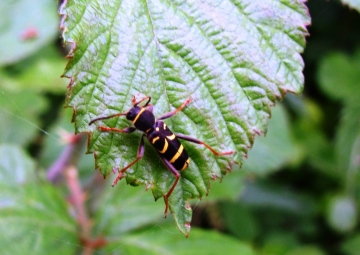
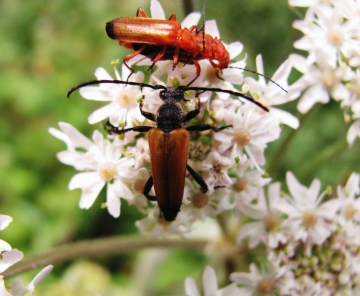
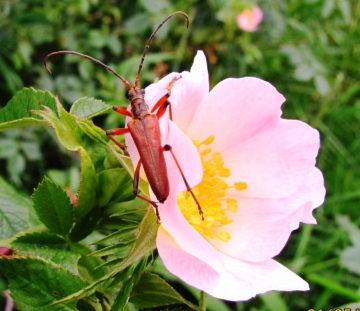
This beautiful Cardinal Beetle Pyrochroa serraticornis(or Bloodsucker as we knew and feared them as children)
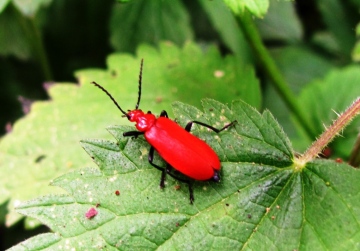
and the Flower Beetle with muscular legs Oedemera nobilis
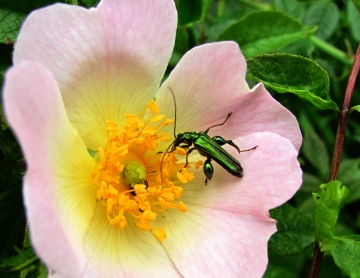
were also among the insects on view during an enjoyable ramble round the aerodrome photographing them as best I could despite the near gale force wind. |
|
Archives:
May 2020
Aug 2019
Jan 2019
Sep 2018
Jul 2016
Oct 2015
Jul 2015
May 2015
Apr 2015
Mar 2015
Feb 2015
Jan 2015
Dec 2014
Oct 2014
Sep 2014
Aug 2014
Jul 2014
May 2014
Apr 2014
Mar 2014
Feb 2014
Jan 2014
Dec 2013
Nov 2013
Sep 2013
Aug 2013
Jul 2013
Jun 2013
May 2013
Apr 2013
Mar 2013
Feb 2013
Jan 2013
Dec 2012
Nov 2012
Oct 2012
Sep 2012
Aug 2012
Jul 2012
Jun 2012
May 2012
Apr 2012
Mar 2012
Feb 2012
Jan 2012
Dec 2011
Nov 2011
Oct 2011
Sep 2011
Aug 2011
Jul 2011
Jun 2011
May 2011
Apr 2011
Mar 2011
Feb 2011
Jan 2011
Dec 2010
Nov 2010
Oct 2010
Sep 2010
Aug 2010
Jul 2010
Jun 2010
May 2010
Apr 2010
Mar 2010
Feb 2010
Nov 2009
Oct 2009
Aug 2009
Jul 2009
Jun 2009
May 2009
Apr 2009
Mar 2009
Feb 2009
Jan 2009
Nov 2008
Oct 2008
Sep 2008
Aug 2008
Jul 2008
Jun 2008
May 2008
Apr 2008
Mar 2008
Feb 2008
Jan 2008
Dec 2007
Nov 2007
current posts
|











































